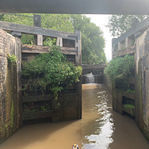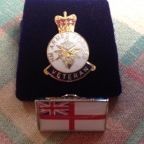PART2 – the regulator
7. Next the regulator. First examine the pipe leading fromthe regulator to the burner pot. This is where condensation collects.
8. Remove the nylon filter. As you can see mine was full of slime, water and general muck.
Pic. 7 Before. It looks as though I had a touch of the dieselbug.
Pic.8 After.
9. Remove the regulator knob and the three screws holding the cover in place.
10. Remove the float assembly by undoing the three screws holding it in place. (Pic14, screws 1,2 and 3)
Pic.9 Float assembly
(A ) controls the height of the metering stem and hence the rate to flow offuel. (B ) controls the fuel level and prevents overflow.
11. Lift out the metering stem and spring. Remove inlet valve and spring. (Note the spring holding the valve open is very weak. I have known one of these to become clogged, preventing the inlet valve from operating.)
Pic.10 Inside of the regulatorbefore cleaning. Note the pool of water!
(A) Outlet tube. Metering stemfits in here. (B ) Overflow pipe. (C ) Inlet valve.
Pic.11. After refitting the float assembly, turn the control knob to fully open and check that the metering stem is free to move up and down.
12. Thoroughly clean out thechamber. If, like mine, your flame doesn't fully extinguish, or you find that there is diesel swimming in the bottom of the burner pot when you comeback to the boat after an interval, it's probably because there is dirt at the base of the metering tube preventing the metering stem from closing fully. If you look carefully you can just see the speck of dirt that was the cause of the trouble.
Pic 12 Inlet valveand spring
Pic.13 Meteringstem. Note the thin delivery slot.
13. There are four adjustments you can make. You shouldn't need to touch them, but it's useful to know how they work..
Metering stem adjustment. (A) in pic.14. This raises the metering stem exposing more or less of the fine slot, thus allowing more or less fuel to enter the fire. If you find that you need to turn the knob up more and more to get the same degree of heat, as a temporary measure you can give this screw a couple of turns clockwise. It doesn't solve the problem of a blocked or dirty regulator, but it might get you out of difficulties in an emergency and keep the fuel flowing.
Overflow level adjuster. (D ) in pic.14. When I moved my Refleks from the motor to the butty, the trim was different and fuel leaked from the overflow pipe. Adjust the level until it the diesel begins to flow then screw it down by half turns until the overflow stops.
(B )and (C )The high fire and low adjusters. These really shouldn't be touched. However, if after renovation and cleaning the fire burns with a dirty yellow billowing flame the mixture is too rich. You should heat the fire up thoroughly and set the flame to mark 4. To make an adjustment, screw the high fire screw (B ) in half a turn at a time, letting the flame settle, until you reduce the yellow licking flames until they are blue with yellow tips. There are detailed instructions on how to do adjust the high and low fire adjustments on the Harworth website . Again,you will only need to do this if someone has fiddled with them instead of tackling the root causes of the problem.
Pic. 14 Adjustments A - D
Assembly is the reverse process. However, to make it easier next time I replaced the rivets with 4mm self tapping screws. Also a little grease round the burner pot made it easier to get back into position without having to apply brute force.
Before lighting, check that oil is flowing. It should be seen instantly in the bottom of the burner pot and should shut off equally quickly. You can also check to see that that the rate of flow changes as you adjust the control knob.
Pic. 15.Fuel should flow freely into the bottom of the burner pot
The change was marked when I lit thefire. Bluish flames, improved responsiveness from low to high andcomplete extinguishing of flame when the control knob is set to zero..
I should add that I'm in no way qualified to offer this advice. I'm not a heating engineer and have had absolutely no training in servicing Refleks stoves. You follow the above steps at your own risk. If in doubt you should consult a professional. I'll be happy to amend anything that I've got wrong.
















